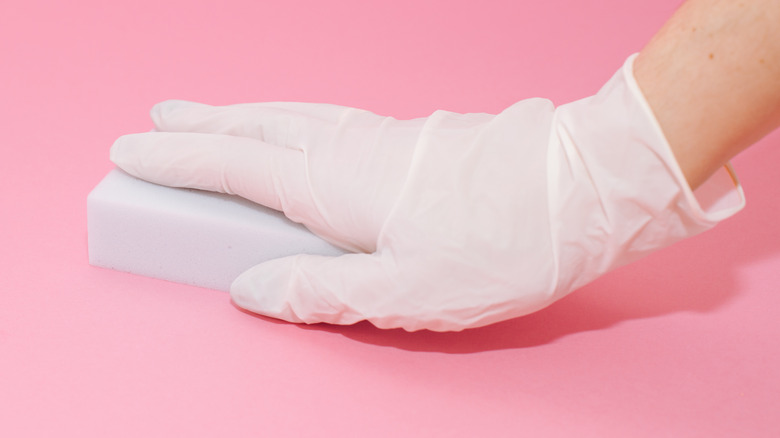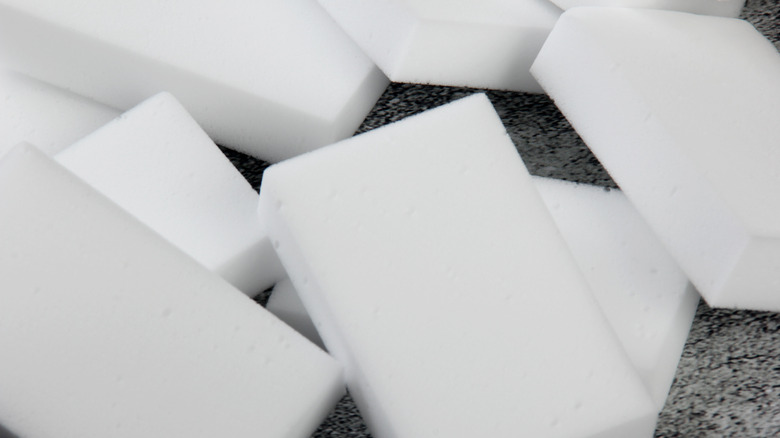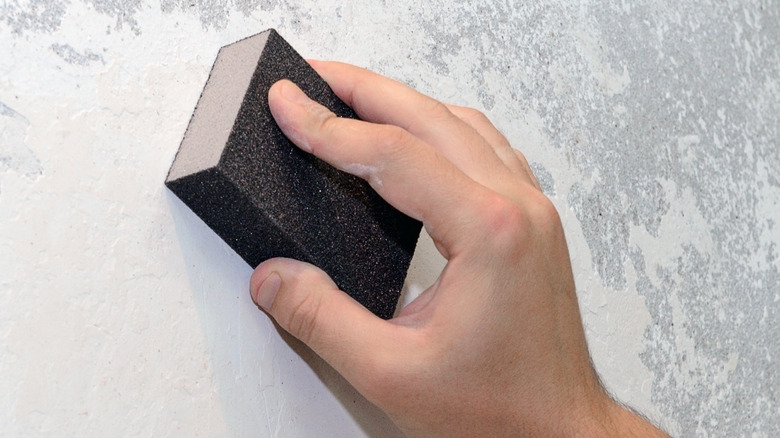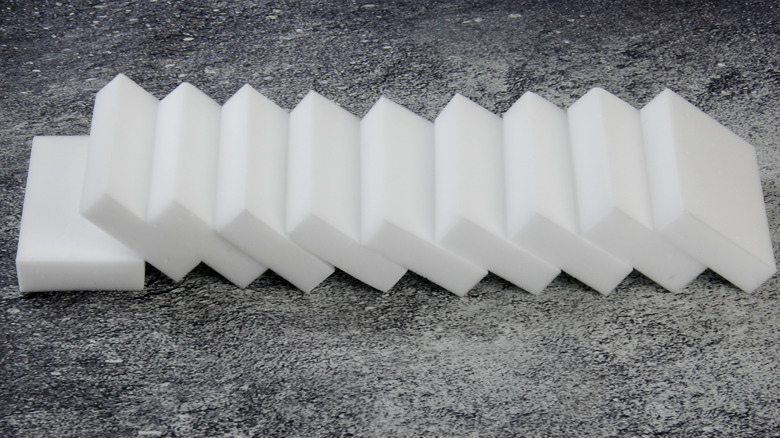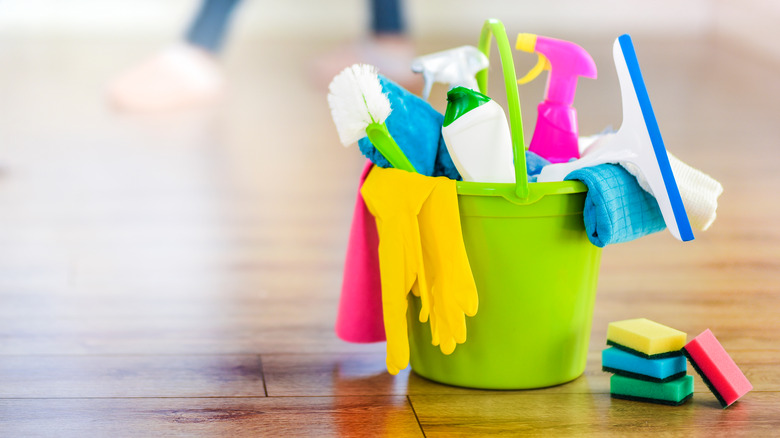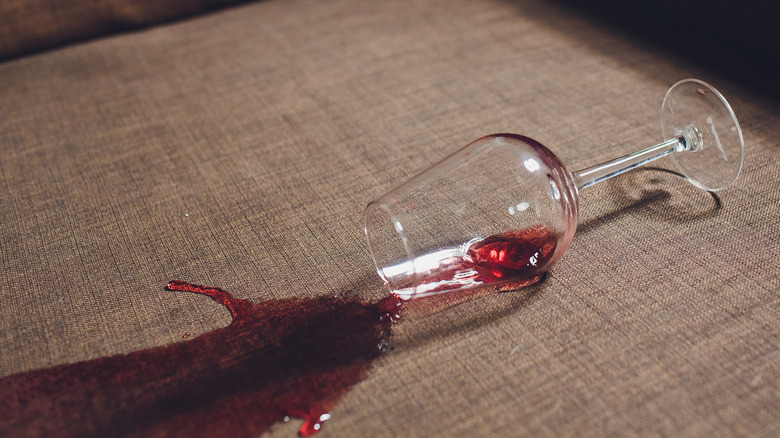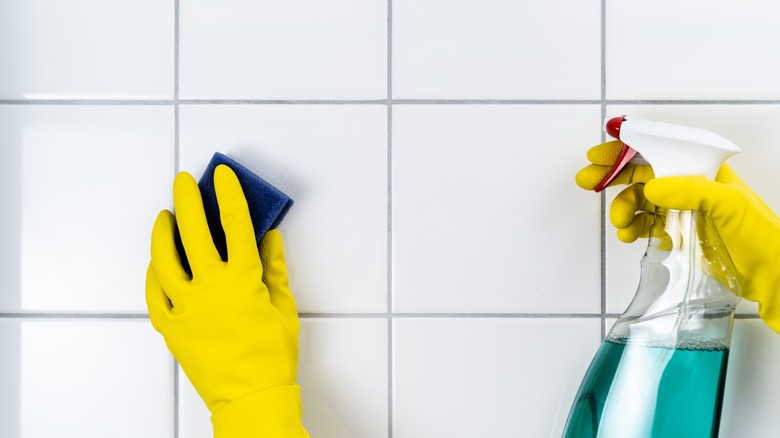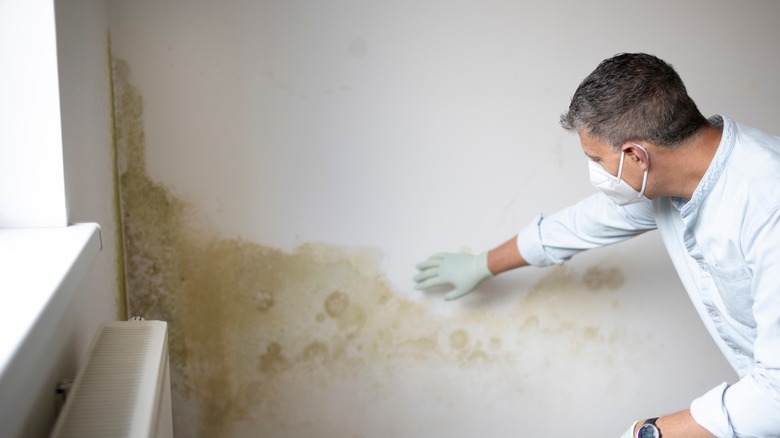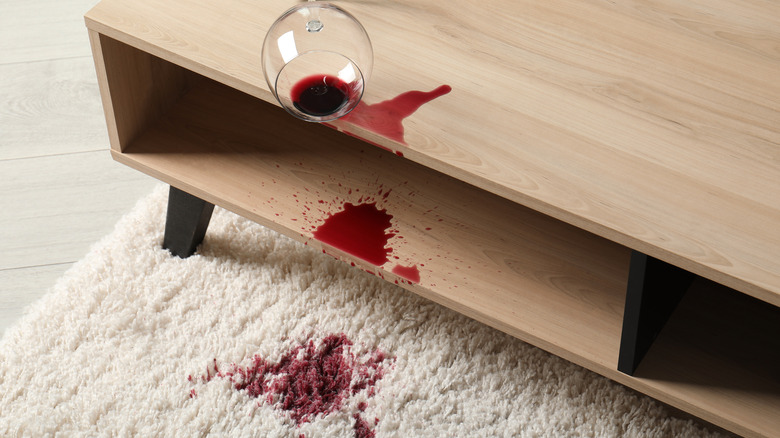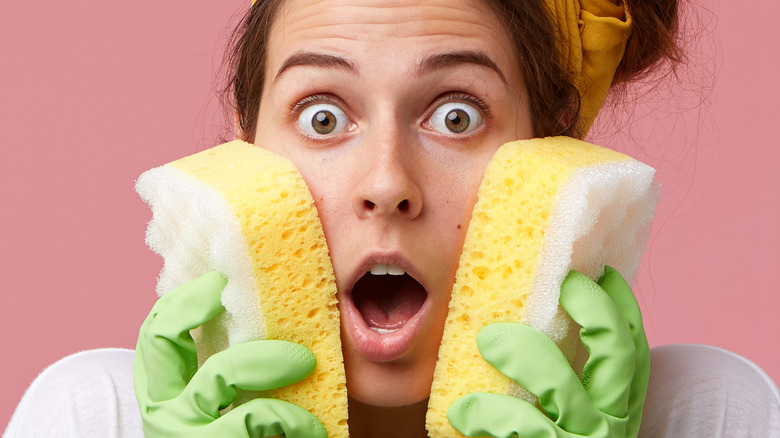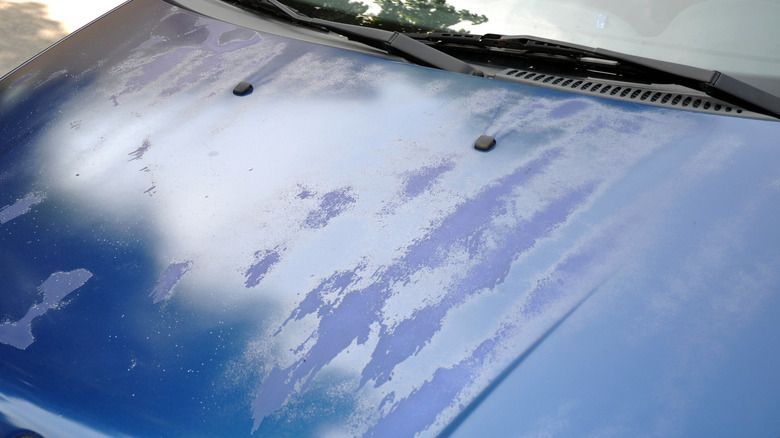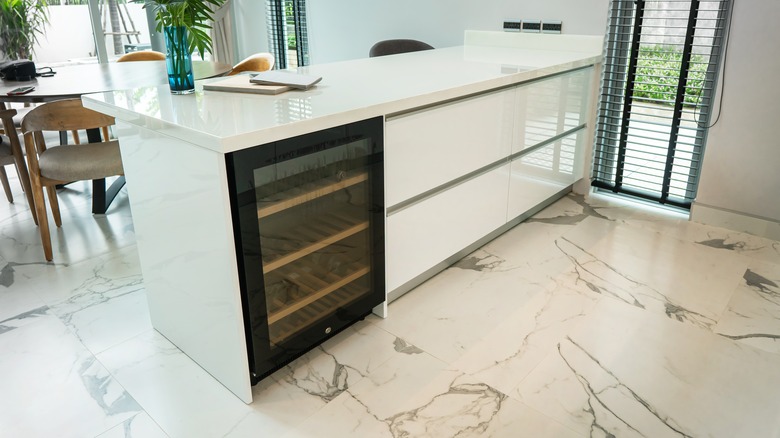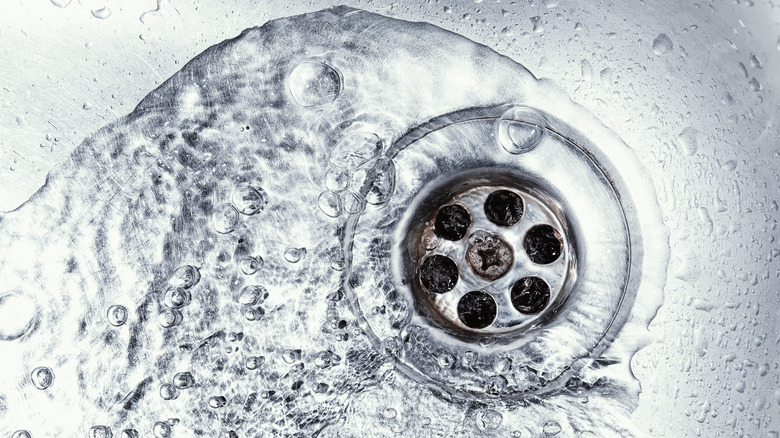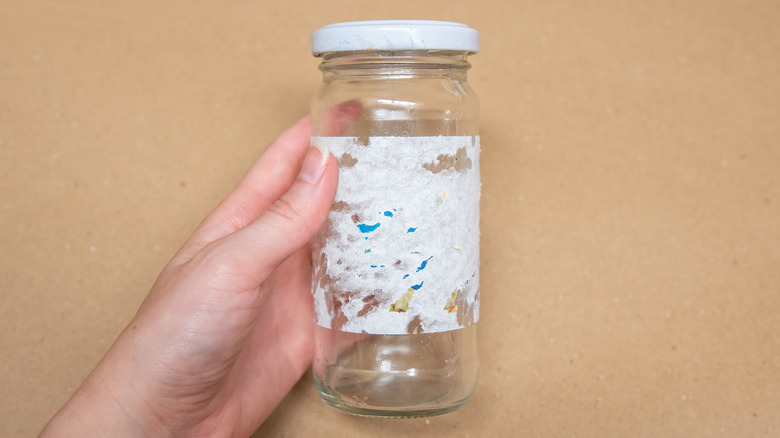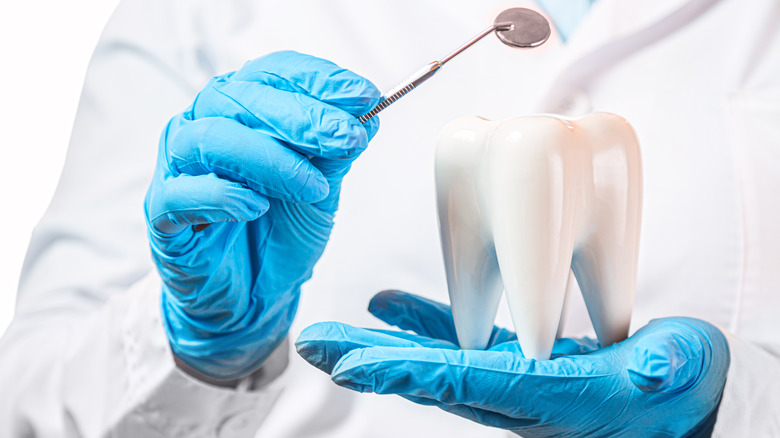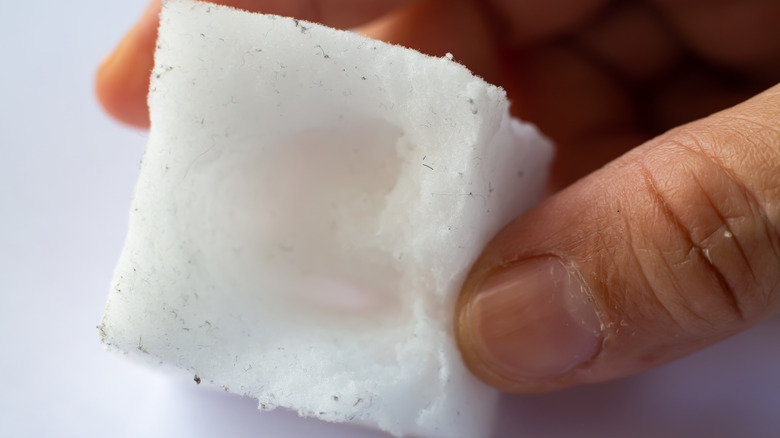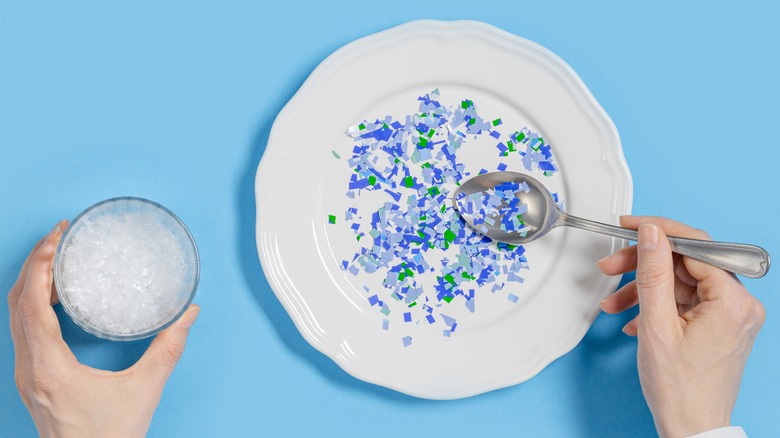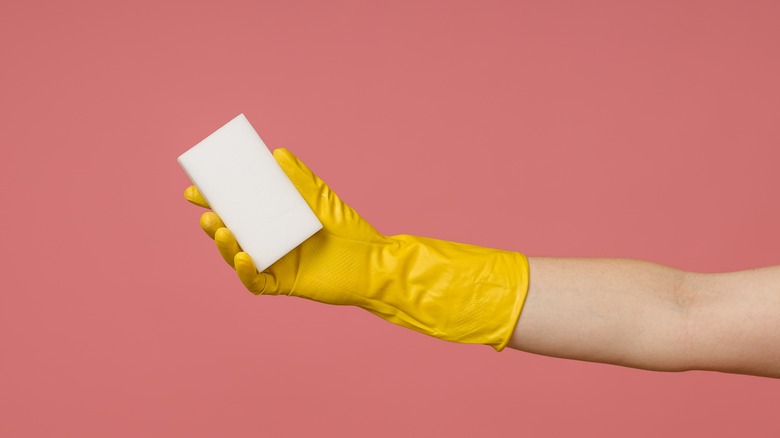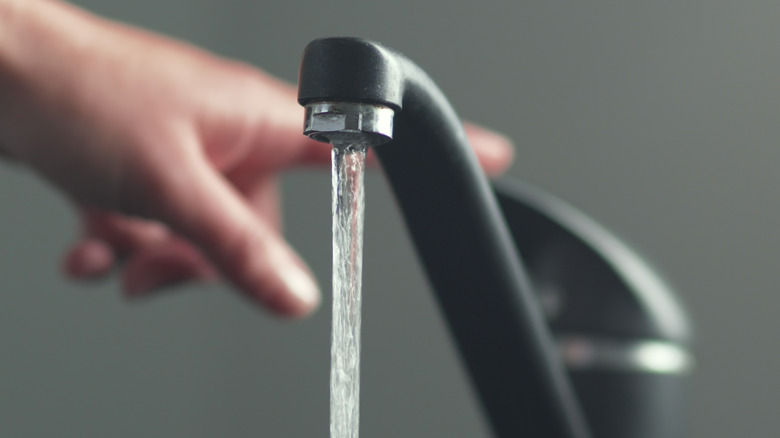The Untold Truth Of Magic Erasers
Magic erasers are great for more than just getting stains off of your countertop. Their structure makes them perfect for picking up grease, food stains, and even some types of glue. There are lots of ways to use them for other things around the house. Magic erasers work well on many kinds of surface stains and dirt, but they also work on nail polish, crayon, and hairspray.
At a little under a dollar apiece, according to Apartment Therapy, these sponge-like cleaning products are versatile and easy to use. Pack one in your go-bag for emergency clothing stains, use them to get tarnish off of silver, and to get scuffs off of tile floors. Find out how you can use them creatively in all kinds of unexpected ways, places you might be surprised to learn that you shouldn't use them, and what makes them work so well in so many places.
Magic Erasers are made from a special kind of foam
While they seem like a kind of sponge, Magic Erasers are made from melamine foam, which is used for audio dampening as well as insulation. While melamine is still used in a variety of ways, in 2003, it was discovered to be excellent for cleaning, because of its sponge-like texture combined with its tiny, hard surfaces that have excellent scrubbing power.
According to Family Handyman, Magic Erasers work both by absorbing grime and dirt into their porous surface and as an abrasive scrub that will remove particles from the surface you're cleaning. Because the tiny cells that the foam is made of are delicate, the structure will break down over time, making the cleaning pads less effective as they get used up. Once you notice the foam starting to get compacted, it's time to break out a new one. If you have a big job, you should plan on going through a few before you're done.
Magic Erasers are abrasive
Magic erasers might seem similar to ordinary sponges, but they're more complicated. In fact, Magic Erasers are the equivalent of about a 3,000 to 6,000-grit sandpaper, making them abrasive, but not as abrasive as, say, a nail file. Because of this abrasive quality, it's recommended to use care when using them on shiny surfaces because they might scrub the shine right off.
Wired points out that in addition to melamine, Magic Erasers contain formaldehyde, bonded to the foam material through a chemical reaction in the form of a hard resin, adding to the scrubbing power of the foam. Each cell in the melamine foam is a tiny bubble of hardened material caused by forced air and the chemical reaction between the melamine crystals and the formaldehyde, making the foam both abrasive as well as porous. That's where the cleaning power comes from. Unlike many cleaning products that use chemical reactions to achieve success, melamine foam pads use friction and absorption to do their work.
You can make your own magic eraser
Making your own magic eraser is very simple; you just need melamine foam. According to ABC Action News, if Magic Erasers are too pricey, you can buy unbranded melamine foam pads for about a nickel apiece. The melamine foam you buy in bulk for pennies is no different at all from the foam that Magic Erasers are made from. Since one of the most common ways that melamine foam is used is in pipe insulation, or for ducts and HVAC, melamine foam can be purchased in large quantities and different shapes and sizes for a very low price.
If you want a different size or shape for your cleaning pad, you can probably find it if you look. If you're going to go through multiple foam pads for larger cleaning projects, it makes sense to get them for even cheaper than the official version. Your newly gleaming surfaces and your wallet will thank you.
You can use magic erasers to clean like a pro
Professional cleaning services use Magic Erasers on all kinds of things, and you can too, according to Maid Sailors. They recommend some of the best uses for Magic Erasers as being for fiberglass tubs and sinks, dry erase boards, and the interior of your car. Other good uses for melamine foam pads are removing scuffs and dirt from sneakers, cleaning glass shower doors, and spot-cleaning walls and baseboards.
To use the foam cleaning pad, just dampen it with a little bit of water and rub in small circles on your surface. Because a Magic Eraser is foam and can absorb liquid, Maid Sailors also recommends rinsing and wringing out your cleaning pad after you use it, and then allowing it to air dry. This method will help you get the most out of your Magic Eraser and prevent it from growing mold or mildew, since you can use it many times before you need to replace it.
Magic erasers can be used on fabric and upholstery
Magic Erasers aren't just for hard surfaces. You can also use them on clothing and furniture. According to Hunker, Magic erasers are good for cleaning upholstery and fabric as well as hard surfaces because they're absorbent. You can save money by getting a few extra miles out of lighter-colored furniture by getting stains out and brightening it up a bit.
To use your Magic eraser on furniture, you should start by removing any dust or debris. A good vacuum should do the trick. Then, wet your eraser and wring it out most of the way so that it's only a little bit damp. Then, apply some pressure to stains you want to remove, rubbing only on the area that is stained. Once the stain is gone, just allow the upholstery to dry. If you need to, you can go back over areas that have stubborn stains more than once. Because the foam is absorbent, using a dabbing motion might help to lift particles of dirt from the surface.
Do Magic Erasers work on grout?
Cleaning grout — whether in your kitchen, bathroom, or somewhere else in your home — can be quite a chore. So, you may wonder if a Magic Eraser can make the job easier. Upgraded Home notes that, in short, Magic Erasers work very well for cleaning grout. In fact, not only does this cleaning tool simplify the process, it actually works exceptionally well to make your tile flooring spotless!
Because Magic Eraser doesn't rely on bleaching agents to clean, it can also clean colored grout without the worry of leaving behind stains. The sponges are so effective on grout because they contain melamine, formaldehyde, and sodium bisulfite, which help fight stubborn grime when mixed (via Wired). Unwanted grime like mold, mildew, and grout haze stand no chance against this cleaning staple. Plus, the sponge may seem soft and fluffy, but it has a texture equal to 3000-grit sandpaper. These factors combined make them a dream for cleaning grout.
Magic Erasers can remove mold or mildew from surfaces
For health and cleanliness purposes, you want to immediately eradicate mold and mildew from your home. A handy Magic Eraser can help you do so with ease! According to DIY By Hand, the first step is to add water to the sponge, which is key every time you use it. Put it in a sink or bucket of water. and wring it out before use, so it's not sopping wet. After that, scrub the mold or mildew-afflicted area using circular motions. Avoid scrubbing too hard, as you don't want to break the foam and render your Magic Eraser unusable.
Afterward, rinse the sponge thoroughly to remove any mold, mildew, or grime that it might have picked up in the cleaning process. This is vital because you don't want mold spores to hang onto your sponge, which can cause a problem later on. Squeeze the Magic Eraser to remove excess water, and place it flat on a piece of paper towel or clean dishcloth so that it can dry completely. Keep in mind that if your Magic Eraser crumbles or falls apart in the cleaning process, you'll want to toss it and start with a new one next time for the best results.
Magic Erasers can tackle both wine and blood stains
Two of the toughest stains to get out of fibers are from wine (namely red wine) and blood. Thankfully, Magic Erasers can aid in this effort if either end up marking their territory unwantedly in your home. First, to get rid of a wine stain — particularly from a wall — Fab How recommends first adding water to your sponge and wringing it out to get rid of excess moisture before use. Then, lightly scrub the wine stain with the sponge until it is no longer visible. The beauty of this process is that it's single-step, whereas using bleach, hydrogen peroxide, or mild detergent takes more steps and materials to eradicate the stain.
Next, Companion Maids sheds light on how you can use a Magic Eraser to get rid of blood stains. If blood stains occur on your furniture or carpet, you can wet your Magic Eraser and wring out excess moisture. Then, like you would for a wine stain, scrub the fabric gently in circular motions to work out the stain. Continue until the stain is diminished and no longer visible, then let the material dry.
Magic Erasers are non-toxic
In spite of their cleaning power, Magic Erasers are non-toxic and safe for pets and kids as long as the sponge itself isn't ingested. While melamine foam has formaldehyde in its chemical makeup, it's misleading to say that it contains formaldehyde. Rather, the chemical structure of the foam causes the formaldehyde to bond with other elements to make a hard, resin-like structure that doesn't release formaldehyde in its harmful form.
According to the Missouri Poison Center, Magic Erasers are made out of formaldehyde-melamine-sodium bisulfite copolymer, but rumors that the foam is toxic are false. They do warn, however, that children can and will take bites out of the foam and that these bits of foam can be a choking hazard. If a child takes a bite of foam, you should take it away, wipe the inside of their mouth with a soft, damp cloth, and rinse their mouth with cool, clean water. Because the foam is abrasive, it's also a skin irritant. It can cause a friction burn if you try to use it to clean bare skin, so it should be kept away from children for this reason.
Magic Erasers are bad for high-gloss finishes
Because they're abrasive, Magic Erasers can damage the surface of high-gloss paints like automotive finishes. 21Oak recommends against using melamine resin foam to clean anything that holds sentimental value, such as collectibles, because the risk of damage outweighs the benefits. Other surfaces to avoid include screens because of the risk of scratching or scuffing, non-stick pots and pans (because the foam can take the non-stick surface off), painted or varnished wood, stainless steel, natural stone, and any high-gloss enamel finishes like car paint. These surfaces are best cleaned with a soft cloth.
If you're not sure whether your surface could be damaged by an abrasive pad, try doing a small test patch in a less-noticeable area like the back side or inside a closet. In general, this is a good practice when trying out any new cleaning product for the first time to avoid damage.
Magic Erasers are bad for natural stone surfaces
Magic Erasers will damage your natural stone countertop or even your floor. If you have polished marble or granite countertops, or even natural stone tile, don't use a Magic Eraser to clean it, according to Countertop Specialty. The abrasiveness of the Magic Eraser can scratch the surface of the stone and ruin the texture. While you can correct minor damage from a melamine foam pad, it's better to just steer clear of them when you're dealing with marble, granite, or other susceptible stone surfaces.
Using polish to correct a small scuff for polished marble or an etch-removing drill attachment for honed finish can help, but it's better to just not take the risk. Instead, use a regular sponge and a cleanser that's made specifically for natural stone. This will make it easier to maintain your natural stone over time, and preserve the sealant that protects it from damage.
Magic Erasers should be used wet
Because of the material they're made of, Magic Erasers work better when they're wet. Mr. Clean says that the melamine foam is "activated" with moisture, but since the cleaning process it uses is more physics than chemistry, it's more accurate to say that its effectiveness is increased when wet. According to Martha Stewart, Morgan Brashear, Mr. Clean senior scientist and cleaning expert, explains that the crystalized melamine actually gets harder when it's wet, even though the foam feels softer.
This is what makes a Magic Eraser work: It's softer than the surface you're cleaning, but harder than the dirt you're removing. A dry piece of melamine foam will bind up on surfaces, and will also fall apart more quickly. Dampening a melamine foam pad allows it to flex and move, absorbing liquids, scraping away dirt, and contouring to fit the shape of the surface being cleaned. While it might be possible to clean a surface with a dry Magic Eraser, it will do a better job if it's damp.
Magic Erasers are good for cleaning keyboards
Magic erasers work well on computer keyboards because the foam can get into all the crevices between keys. Unless your keyboard is high gloss, you can use a Magic Eraser to get in between the keys and down into every crevice. This is one instance where the less water involved, the better because of the risk of damage to the electronics. Make sure that you wring out the Magic Eraser well before attempting to use it on a keyboard.
Expert Home Tips warns that pushing too hard on a brushed metal surface with a Magic Eraser can leave scratches, so make sure to be gentle when you're trying this method out. You should also avoid pushing hard enough to expel water into the cracks in your keyboard, so be gentle and take your time if you decide to try out a Magic Eraser on your laptop. You should also never clean your computer screen with a Magic Eraser, but use a microfiber cloth instead.
Magic Erasers will remove sticker glue
Stubborn sticker residue can be challenging, but Magic Erasers can do the trick to get rid of it. Rather than scraping, soaking, re-scraping, using harsh thinners or cleansers that are harmful to inhale, heating, scrubbing some more, and giving up, try using a Magic Eraser to get rid of the sticky glue left behind by price stickers or labels, advises Apartment Therapy.
Magic Erasers work sort of like scraping with a knife or squeegee except that they use their abrasive and absorbent structure to scrape exponentially more than a few passes with your hand. Using small, circular scrubbing motions will do the best job of releasing sticker goo. Start off gently and increase pressure as needed to avoid damage to the surface you're trying to clean. Take care when using this method on anything shiny, as the melamine foam might damage the surface.
Don't use Magic Erasers on your teeth!
Magic Erasers are non-toxic, but that doesn't mean you should use them on your teeth. While you might have seen a viral video about someone cleaning their teeth with a Magic Eraser, WGNTV in Chicago reported an appeal from dentists to never do this to your mouth. Dr. Richard Black told WGNTV that using Magic Eraser on your teeth could cause lifelong damage. If a dentist's warning isn't enough to dissuade potential melamine foam dental adventures, try the label on the package that specifically says not to use the product on skin or any body part.
Having white teeth is a popular pursuit, but using something that's essentially micro-sandpaper on your teeth will damage your enamel, especially if you do it more than once. On top of the potential damage you could do to your teeth, you can also give yourself friction burns on the inside of your mouth. Stick to whitening strips made for teeth and save the Magic Erasers for cleaning sneakers and deck furniture.
Magic erasers don't disappear when you use them
If you've ever used a melamine foam pad to clean with, you might assume that the sponge-like tool is slowly dissolving as you go, based on its smaller and smaller size as it gets used. Surprisingly, rather than actually dissolving, Magic Erasers actually break down into super-abrasive microplastics that can wash down drains and into the environment. The sponges compress with use, Live Green Recyclebank points out, but they don't simply disappear.
Rather, they do something much worse, which is shed tiny particles of melamine resin onto the surfaces you're cleaning with them. Microscopic plastic particles can be found wherever your Magic Eraser has been. While they don't use a chemical process to clean surfaces, they're also not the most environmentally-friendly of cleaning tools because they get used up and disposed of rather than washed and reused, and it's hard to control where the particles they release end up because they're so tiny.
You shouldn't do your dishes with a Magic Eraser
Despite their mythical status as cleaning powerhouses, Gimme the Good Stuff says that Magic Erasers aren't good for cleaning anything you eat off of because they can leave behind tiny particles of compressed melamine that you can ingest. There's not a lot of research on what consuming microplastics will do to your body, but it's a safe bet that swallowing abrasive particles should be avoided where possible.
Cleaning your dishes regularly with a Magic Eraser will ensure that you ingest a fair amount of microplastics over time. While the melamine foam itself isn't toxic, it's probably a good idea not to eat plastic, so while scrubbing a price sticker off of a plate probably won't hurt you, using a Magic Eraser as your main dish-cleaning tool is a bad idea. The other thing that happens when you use melamine foam regularly in your sink is that you will wash microplastics down the drain and into the water table.
How long will Magic Erasers last?
Magic Eraser users tend to wonder how long the tool will last. Knowing this will help you best plan when you need to replace yours. A few factors come into play as far as duration, though. According to DIY By Hand, Magic Erasers should last between one to 10 uses. This is quite a range, but depending on what you're using yours for, it will last a different amount of time. There are a few things you could be doing that will degrade your Magic Eraser faster. The first thing is scrubbing too hard with the cleaning tool. Even though they feel soft to the touch, you don't need to scrub too hard in most cases for the Magic Eraser to work its, well, magic.
Additionally, using the Magic Eraser when it's not wet enough will potentially cause it to shred or tear apart. Be sure to run the eraser under water for at least a few seconds before you use it to tackle a stain. Finally, using harsh chemicals with a Magic Eraser could reduce its lifespan. It's best to use yours with just water rather than in conjunction with other cleaning agents.
Do you need to rinse Magic Erasers after you use them?
Many Magic Eraser users contemplate whether or not they should rinse the sponge after each use. According to Mr. Clean himself, this is the best practice to keep your sponge intact for as long as possible. After cleaning up your mess, rinse the sponge of any dirt or grime, and let it air dry before putting it back into storage. This will ensure it won't get mildewy or crumbly, allowing you to squeeze more uses out of it.
However, if you used it to rid your home of mold and mildew, make sure to take an extra step and rinse it exceptionally well after, as you don't want mold to reside in the sponge going forward. Doing so will potentially contaminate any surfaces or walls you clean it with, creating a bigger mess than you started with.
